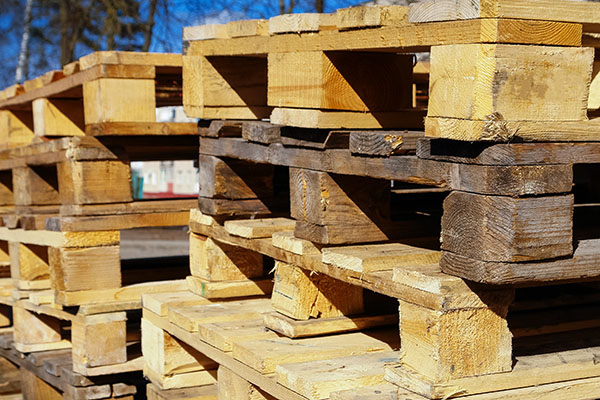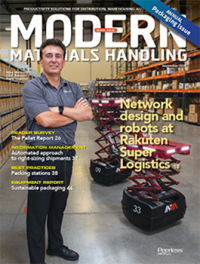The Pallet Report: State of the pallet industry
As more companies automate their materials handling, storage and palletizing operations, the need for higher quality, reliable pallets that can go the distance is on the rise.
After doing dozens of pallet tests for large organizations, Laszlo Horvath realized that pallet compatibility was a top-of-mind issue for companies as they invested in automated materials handling, palletizing/de-palletizing machinery and storage equipment.
“The issue was coming up a lot,” says Horvath, director of the Center for Packaging and Unit Load Design at Virginia Tech University. “A lot of companies were concerned that the pallets they were using weren’t designed for use on certain equipment,” Horvath continues, “with the primary culprits being low-quality pallets that were clogging and jamming their systems.”
In a business environment where every second counts, and where customers won’t wait more than a day or two (if that) for their orders, these setbacks could mean the difference between staying competitive and falling behind.
Horvath says degradation of the pallet pool—and particularly the used pallet pool—was another key concern for the companies he was working with. This pushed him to have some conversations with the National Wooden Pallet and Container Association (NWPCA). Pointing out that pallets are constructed in a cost-conscious way, built for a specific number of trips, and then sent to recyclers to fix and put back into circulation, Horvath says lowerquality pallets are getting more and more difficult to reuse.
“We’re at a point where you can’t repair them multiple times anymore,” Horvath says, “so they get sent to the landfill.” The proliferation of automation is playing a part in this circle of life, he adds, and will continue to be “an issue that we have to address.” Working with Virginia Tech grad student Alina Mejias Rojas, who as part of her master’s thesis helped to collect, analyze and report on the data, Horvath conducted a study in collaboration with Modern Materials Handling and Peerless Research Group (PRG).
Through it, they hoped to better understand current practices, trends and issues related to the usage of pallets in materials handling environments. In particular, the research is meant to help warehouse and DC managers assess which pallet characteristics and practices help reduce operational downtime, minimize product damages, eliminate added costs associated with maintenance and mitigate serious accidents that may occur in supply chain operations.
Rojas says the topic was interesting to her based on the lower variability presented by automated and semiautomated materials handling and storage equipment. “Wooden pallets are well known and preferred because they can adapt to different areas of the warehouse,” she explains. “However, automated or semi-automated systems work with little or no variability. I wanted to figure out why so many companies were having issues blending the two, and see what options were out there for them.”
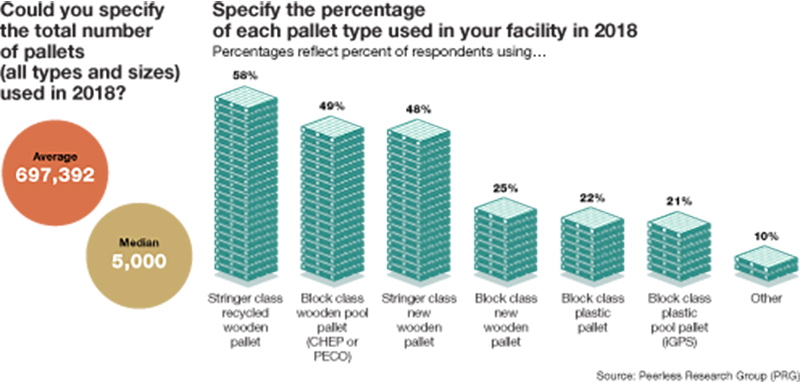
How it all stacks up
Of the 259 individuals who responded to the e-mail survey of Modern subscribers, 58% use stringer class recycled wooden pallets, 49% rely on block class wooden pool pallets (CHEP or PECO), and 48% use stringer class new wooden pallets. The respondents were all readers employed at a location that uses pallets. The typical company is using 697,392 pallets in their operations, with the media usage number being
5,000. The most popular pallet size is 48 x 40 inches (62% use these), followed by 48 x 42 inches (24%), and 42 x 42 inches (18%).
Survey respondents work in a variety of different industries, including food (10%), consumer goods (8%), chemical (5%), beverage (3%) and aerospace (2%). Most are managers or supervisors (37%), followed by general managers or department heads (24%), engineers (11%) and presidents/CEOs (10%).
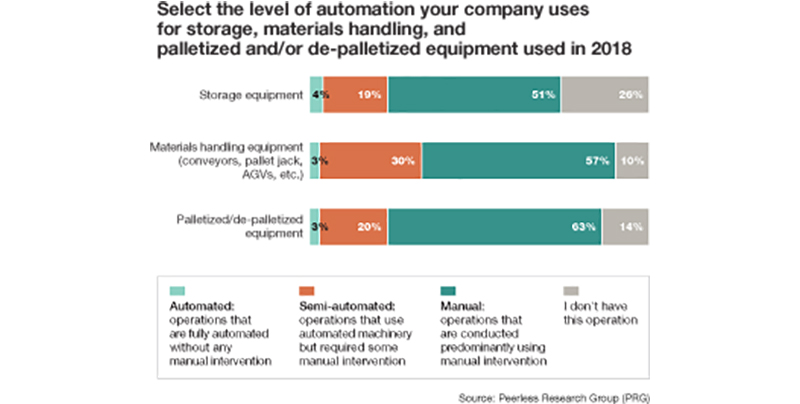
Asked about their current level of storage, materials handling and pallet-related automation, 23% of companies are using automated palletizing/de-palletizing equipment; 33% rely on automated materials handling equipment (e.g., conveyors, pallet jacks and automatic guided vehicles), and 23% use automated storage equipment. A large portion of companies—anywhere from 51% to 63%, depending on the specific equipment—continue to use manual systems for storage, materials handling and pallet-related functions.
Estimating the percentage of pallet locations for each storage trip in their facilities in 2018, 66% of companies say they’re using floor stack or stack rack storage, while 42% prefer selective racks. Thirty-nine percent of companies use drive-in or drive-through racks, while 29% prefer push-back racks. Addressing the key issues When asked how often they face pallet-related issues with their storage equipment operations, the biggest issue that surfaced was poor quality or bottom boards that result in jams or faults.
Fifty-three percent of respondents deal with this problem on either a daily or weekly basis, while another 25% say it happens monthly. Other challenges include missing or damaged components that cause improper unit load placement; excessive pallet deflection; inconsistent pallet dimensions; and other missing or damaged components. In their warehouses and DCs, the most popular materials handling equipment includes forklifts (88%), pallet jacks (86%), roller/conveyor belts (67%), chain conveyors (33%), and elevators (27%).
Their biggest pallet-related issues include loose or broken pallet components getting caught in the rollers (21% of respondents say this happens daily or weekly); incorrect placement of bottom deckboards leading to split or damaged pallets (38%), poor quality or missing bottom boards (31%), and other missing or damaged components (25%).
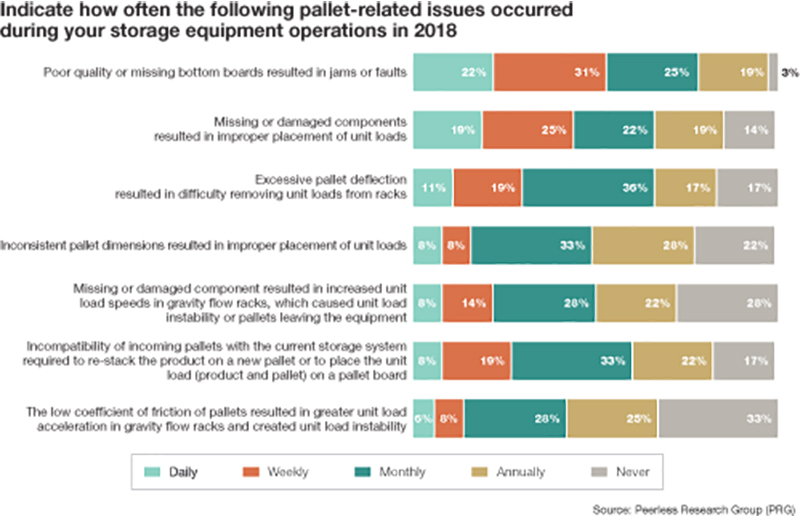
Other issues that companies face in this area include inconsistent pallet dimensions that cause improper unit load placement; inadequately designed pallets creating increased unit load vibrations on conveyors; and small-sized pallets causing stability issues and product damage. In their warehouses and DCs, the bulk of companies (76%) are using conventional (rowstrip or similar) palletizer/ de-palletizer equipment, while 24% rely on robotic equipment to handle their pallet-related operations.
Asked which pallet-related issues typically surface during these operations, 54% of respondents say they deal with missing or damaged bottom deckboards on a daily, weekly or monthly basis. As a result, they wind
up with improper pallet positioning or skewed load placements on the pallets. Other issues include non-flat or uneven pallet deckboards (cited by 50% of companies) that either impact stacking stability or cause jams; inconsistent pallet dimensions (50%); and missing top deckboards (51%) that create unit load instability.
In most cases, stringer class wood pallets and block class wooden pool pallets are to blame for the problem (38% and 23% respectively, according to respondents), followed by stringer class new wooden pallets (13%). Horvath says that at least in some cases, overall pallet quality is another culprit. A company that’s using lowquality, recycled pallets in a highly efficient, fully automated DC, for example, is bound to run into problems.
“The more lower quality pallets you buy, the more flexibility you need to have in your system,” he explains. “The higher level of automation you have in place, the lower the levels of flexibility.” “Missing or damaged bottom decks can create many different problems and are two of the main elements that survey respondents complained about,” says Horvath. “That part of the pallet touches the conveyor, so if the bottom deck is too narrow, you wind up with a lot of shaking and pallets getting stuck on the conveyor.” And if the bottom deck and/or sensor is completely missing, that pallet may roll forward 6 or 7 inches before coming to a stop.
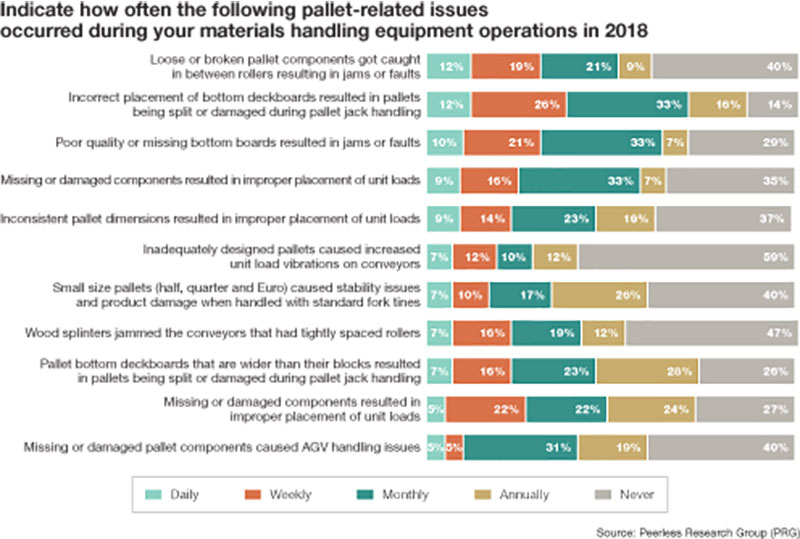
Addressing the challenges
Survey respondents are tackling their pallet issues from a number of different angles. One assigned an associate to dispose of bad wood and reassess good wood for usage, for instance, while another is reducing its number of pallet vendors to drive more consistency in the pool. Other strategies cited include doing in-house pallet rework to ensure 100% fit and finish; procuring higher quality pallets; and implementing quality control systems focused on verifying outbound loads.
To companies that want to resolve these and other issues and invest in new pallets this year, Horvath says a good approach is to measure the effect that the current pallet pool has on fulfillment and distribution operations. “You can’t fix what you don’t measure, and people don’t always factor in the pallets’ effect on their equipment,” he says. “Yet, there are some pretty big hidden costs that no one ever sees.”

Article Topics
Packaging News & Resources
Registration open for Pack Expo International 2024 Pack Expo East has largest show to date Optimize Parcel Packing to Reduce Costs CMC Packaging Automation North America unveils Tech Center in Atlanta PACK EXPO East brings latest packaging technologies to Philadelphia Loftware’s cloud-based labeling solutions take center stage Flexcon unveils its innovative bin solutions More PackagingLatest in Materials Handling
Registration open for Pack Expo International 2024 Walmart chooses Swisslog AS/RS and software for third milk processing facility NetLogistik partners with Vuzix subsidiary Moviynt to offer mobility solutions for warehouses Materials Handling Robotics: The new world of heterogeneous robotic integration Lucas Watson appointed CSO for Körber’s Parcel Logistics business in North America Hyster recognizes Dealers of Distinction for 2023 Carolina Handling names Joe Perkins as COO More Materials HandlingAbout the Author
Subscribe to Materials Handling Magazine

Find out what the world's most innovative companies are doing to improve productivity in their plants and distribution centers.
Start your FREE subscription today.
April 2024 Modern Materials Handling

Latest Resources


